Artificial intelligence (AI) has made significant strides in revolutionizing medical diagnostics in recent years, and its potential to improve patient care continues to expand. Among the latest groundbreaking advancements is an innovative AI tool to detect hidden heart disorders from electrocardiogram (ECG) photos.
ECGs are a crucial diagnostic tool for assessing cardiac health. However, accurately identifying subtle abnormalities can be challenging for even experienced clinicians. This new AI-driven solution aims to bridge that gap, providing faster and more accurate detection of heart disorders, ultimately leading to early intervention and improved patient outcomes.
A breakthrough in cardiac diagnostics: an AI-powered deep learning application now enables automated screening for left ventricular (LV) systolic dysfunction. This condition significantly impairs heart pumping capacity and increases the risk of premature death.
Developed by Dr. Rohan Khera and his team at the Cardiovascular Data Science Lab (CarDS) at Yale University, this novel electrocardiogram (ECG) interpretation provides a feasible, global solution for early detection of LV dysfunction, which was previously challenging without expensive imaging tests. Published in the journal Circulation on July 25, the study showcases the potential of ECG as a widely accessible and effective tool in identifying patients at risk of LV dysfunction, allowing for timely intervention and improved outcomes.
Dr. Rohan Khera and his team developed a groundbreaking AI algorithm using nearly 400,000 paired ECGs and heart dysfunction data from imaging tests. Tested across various formats and datasets from U.S. clinics, hospitals, and a large Brazilian community cohort, the algorithm proved capable of providing crucial insights into cardiac structure and function disorders.
This innovation opens the door to a simple and accessible screening tool for up to one in 20 adults globally affected by these conditions. The AI-powered application, hosted by the CarDS Lab, serves as a super-reader of ECG images, accurately identifying signatures of left ventricular systolic dysfunction, surpassing human capabilities in diagnosis.
Khera said, “Our AI tool allows early diagnosis and treatment and also identifies those at future risk of developing LV dysfunction. The findings represent our ongoing effort to make the application of AI-driven advanced ECG inference accessible.”
In conclusion, the innovative AI tool showcased its remarkable potential in detecting hidden heart disorders from ECG photos. It exhibited high accuracy and efficiency by leveraging advanced algorithms and deep learning capabilities, significantly aiding healthcare professionals in early diagnosis and improving patient outcomes. This groundbreaking technology marks a significant step forward in medical diagnostics, promising a brighter future for the early detection and treatment of heart-related conditions.
Journal Reference:
- Veer Sangha, Arash A. Nargesi et al., Detection of Left Ventricular Systolic Dysfunction From Electrocardiographic Images.Circulation.DOI:10.1161/CIRCULATIONAHA.122.062646.
